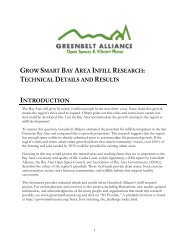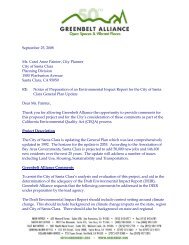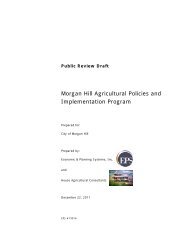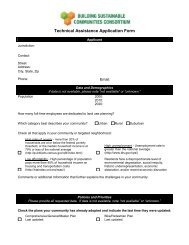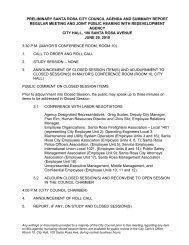You also want an ePaper? Increase the reach of your titles
YUMPU automatically turns print PDFs into web optimized ePapers that Google loves.
Clean Water<br />
<strong>Greenbelt</strong> lands play an essential role<br />
in purifying drinking water and<br />
protecting the San Francisco Bay. As<br />
rain falls onto greenbelt lands, plants<br />
and soil act as natural—and free—<br />
filters and sponges to keep the water<br />
clean and slow its flow, preventing<br />
flooding. When land is developed,<br />
these free filtration and flood prevention<br />
services are lost.<br />
Sprawl development puts the Bay<br />
Area at much greater risk of floods<br />
and water pollution. The short,<br />
intense rainy season already makes<br />
the region vulnerable to flooding, and<br />
sprawl makes floods more intense,<br />
frequent, and dangerous. Polluted<br />
runoff that flows into the Bay and the<br />
Delta degrades their ecosystems, and<br />
endangers valuable fish and shellfish.<br />
Pollution in the Delta also affects the<br />
drinking water of millions of<br />
Californians.<br />
Spectacular Views<br />
The sight of a distant hillside glowing<br />
in the sun, dotted with grazing cows<br />
or patches of oaks, is familiar to<br />
virtually every Bay Area resident. The<br />
preservation of these vistas through<br />
generations of growth took commitment<br />
and foresight by earlier generations.<br />
That legacy continues today, as<br />
Bay Area communities adopt hillside<br />
protection ordinances and urban<br />
growth boundaries, helping to<br />
preserve these familiar, spectacular<br />
views.<br />
Sprawl developments on the region’s<br />
hillsides mar the landscape without<br />
making any meaningful contribution<br />
to the region’s housing supply. Intact<br />
hillsides are an inspiring reminder of<br />
the Bay Area’s heritage; developed<br />
ones are a reminder of how easily<br />
that heritage can be wasted.<br />
Recreation<br />
Just as people enjoy looking to the<br />
hills, they also enjoy walking, biking,<br />
and running in them. The Bay Area’s<br />
many parks provide a wide range of<br />
Photo: Galen Rowell/Mountain Light<br />
The Bay Area’s undeveloped hillsides catch and filter water that runs into the<br />
San Francisco Bay and the San Joaquin-Sacramento River Delta, providing clean<br />
drinking water and helping to prevent floods.<br />
recreational opportunities, from<br />
strolling and picnicking to mountain<br />
biking and mushroom hunting. These<br />
recreational opportunities make a<br />
critical contribution to the culture,<br />
lifestyle, and economy of the Bay Area.<br />
Sprawl development threatens the<br />
quality of these recreational experiences;<br />
a walk in the woods is less<br />
satisfying when subdivisions loom<br />
just over the fence. Moreover, as the<br />
population of the region grows, more<br />
park space and recreational opportunities<br />
will be needed to ensure that all<br />
Bay Area residents have access to the<br />
region’s great outdoors.<br />
A Vibrant Economy<br />
The Bay Area’s economy depends on<br />
the region’s identity as an attractive<br />
place to live and work. Companies<br />
use the beauty of the region to attract<br />
highly skilled workers; the region’s<br />
innovation-based economy is rooted<br />
in the spectacular landscapes that<br />
define the Bay Area. In addition, the<br />
region’s strong agricultural sector is a<br />
significant contributor to the economy.<br />
Sprawl development threatens the<br />
scenic landscapes and compact,<br />
inviting communities that draw<br />
people to the Bay Area. In addition,<br />
the speculative pressures that accompany<br />
sprawl development threaten to<br />
squeeze farmers out of the Bay Area<br />
and undercut a major sector of the<br />
economy.<br />
Compact Development<br />
Finally, an intact Bay Area greenbelt<br />
generates value by helping to guide<br />
good development. With a protected<br />
greenbelt surrounding cities and<br />
towns, new growth can improve<br />
quality of life, instead of creating<br />
more traffic and destroying open<br />
space. High-quality infill development<br />
mixes land uses, putting homes,<br />
shops and jobs close to one another,<br />
so residents don’t have to drive for<br />
every errand. Good infill also<br />
includes housing options for people<br />
of all income levels. This is a crucial<br />
part of reducing pressure to develop<br />
the greenbelt.<br />
Ultimately, the goals of protecting<br />
open space and encouraging compact<br />
development in cities are inextricably<br />
linked. Each requires the other, and<br />
each makes the other possible. If the<br />
Bay Area can commit to both, the<br />
result will be a thriving greenbelt and<br />
a thriving region.<br />
12 <strong>At</strong> <strong>Risk</strong>: The Bay Area <strong>Greenbelt</strong>




